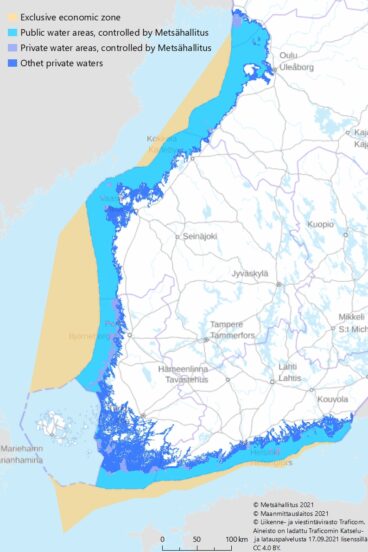Water areas controlled by Metsähallitus
Metsähallitus controls approx. 610,000 hectares of lakes and 2.8 million hectares of sea areas, accounting for more than one half of Finland's territorial waters.
In terms of using water areas, the crucial factor is whether they are public or private. Public water areas and the bottoms of watercourses are the property of the Finnish government, with the exception of those in the Åland Islands, which belong to the Government of Åland. With some exceptions, all public waters belonging to continental Finland are controlled by Metsähallitus.
Public water areas are found in the Finnish territorial waters and open stretches of large lakes defined as having a length and width of eight kilometres or more. Small islands may also be found in public waters.
Metsähallitus’ role in water areas
Metsähallitus’ role in public water areas is to perform the property owner’s tasks. We, for example, investigate the suitability of public water areas for aquaculture, wind farms or excavation of rock material in the seabed. The results of our underwater ecological surveys are central to this work. As the steward of these waters, we also carry out wilderness supervision in public water areas and grant permits for keeping salmon fyke nets in public sea areas. Otherwise fishing and hunting in these areas is free as a rule. We are also responsible for the protection of water areas.
Metsähallitus also manages private waters and shares in private co-operatives of inland waters and sea areas. They are subject to the same legislation as water areas owned by private persons or communities. Metsähallitus is additionally responsible for the protection of our water areas in recreational fisheries found in private waters.
We carry out extensive surveys of aquatic nature in marine and inland waters, partly also outside the areas managed by us. The results of our surveys are used for the spatial planning of different activities, including wind farms and aquaculture and, for example, determining the authorities’ permit conditions in the sea area.
Many different protected areas include waters. Five Finnish national parks are located in sea areas: the Gulf of Finland, Ekenäs Archipelago, Archipelago, Bothnian Sea and Bothnian Bay National Parks. Some of the state-owned areas within the boundaries of the Archipelago and Bothnian Bay National Parks are public waters.
Metsähallitus does not control water areas in Finland’s exclusive economic zone, and we consequently do not participate in managing this zone. However, Metsähallitus can provide the Ministry of Economic Affairs and Employment with expert assistance in such issues as wind power construction.
Marine zones
The Finnish sea area consists of the exclusive economic zone and territorial waters, which are further divided into internal and external territorial waters. The external territorial waters are also known as the territorial sea. The zone to which a sea area belongs partly determines what is possible within it and who controls it.

The inner boundary of the internal territorial waters extends to the shores of the mainland, while the external boundary is formed by a baseline drawn through station points. The station points are located on the outermost points of terrain, either on the mainland, on islands or islets, or in shallows.
A significant proportion of the internal waters closest to the coast are private and often managed by co-operatives. In the outer part of this zone, there are many water areas fully controlled by Metsähallitus.
The external territorial waters (territorial sea) are located between the exclusive economic zone and internal territorial waters. The external territorial waters extend 12 nautical miles from the baseline formed by the external boundary of the internal territorial waters, unless an exception to this rule must be made due to the narrowness of the water area. Most of the external territorial waters are managed by Metsähallitus.
The exclusive economic zone is found outside the external territorial waters, or the territorial sea. Finland’s exclusive economic zone comprises the sea area directly associated with the Finnish territorial sea, the external border of which is determined under treaties concluded by Finland with other states. The location of the external border is laid down in a Government Decree.
While Finland’s territorial sovereignty is limited to the external boundary of the territorial sea, the country has jurisdiction over the exclusive economic zone and full rights to its natural resources. The rights of other states in the exclusive economic zone include the freedom of navigation and overflight, freedom to lay subsea cables and pipelines, and freedom for other uses of the sea related to these freedoms recognised under international law which are compatible with the provisions of the United Nations Convention on the Law of the Sea. The Government’s consent (resolution) is required for economic exploitation of Finland’s exclusive economic zone.
Whereas Finland’s national legislation is applied in Finnish territorial waters, ships of other countries have the right to innocent passage through the territorial sea.